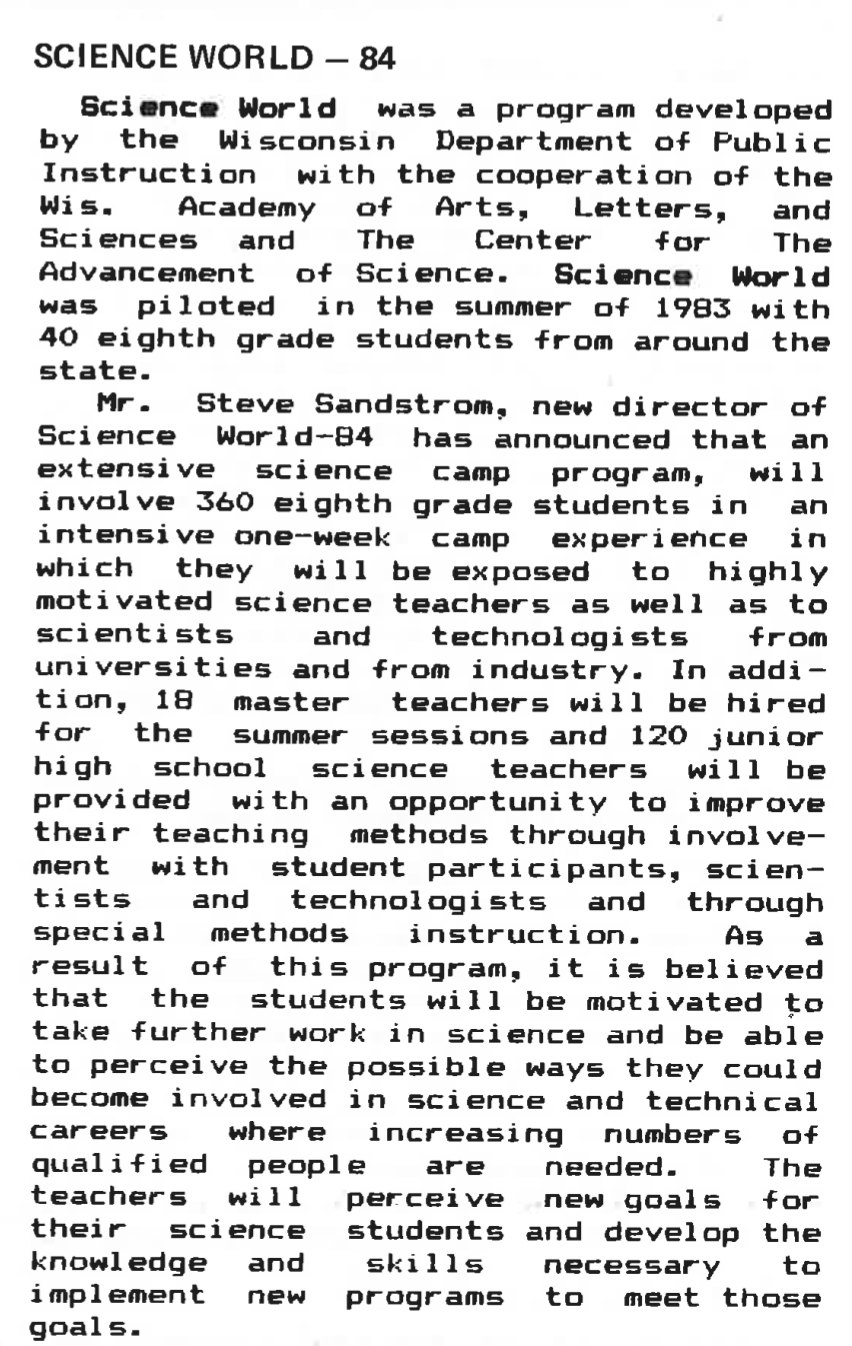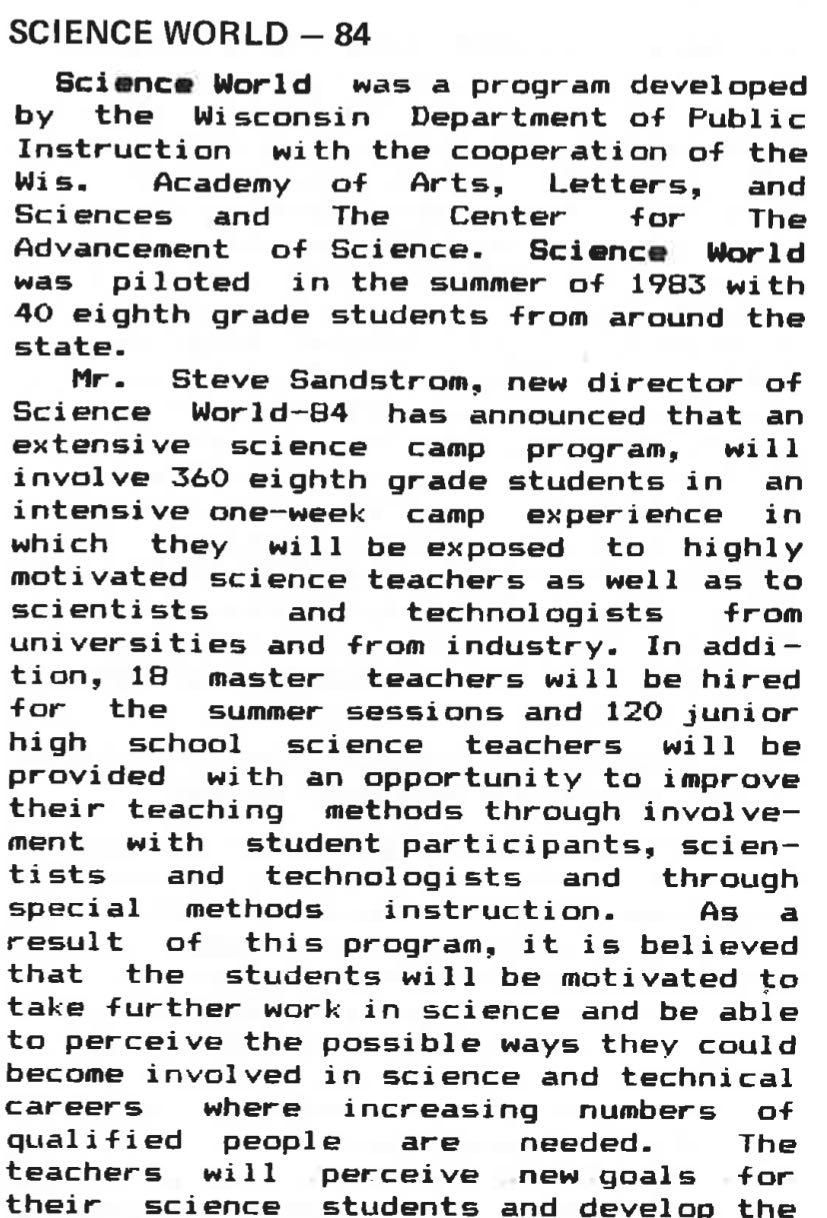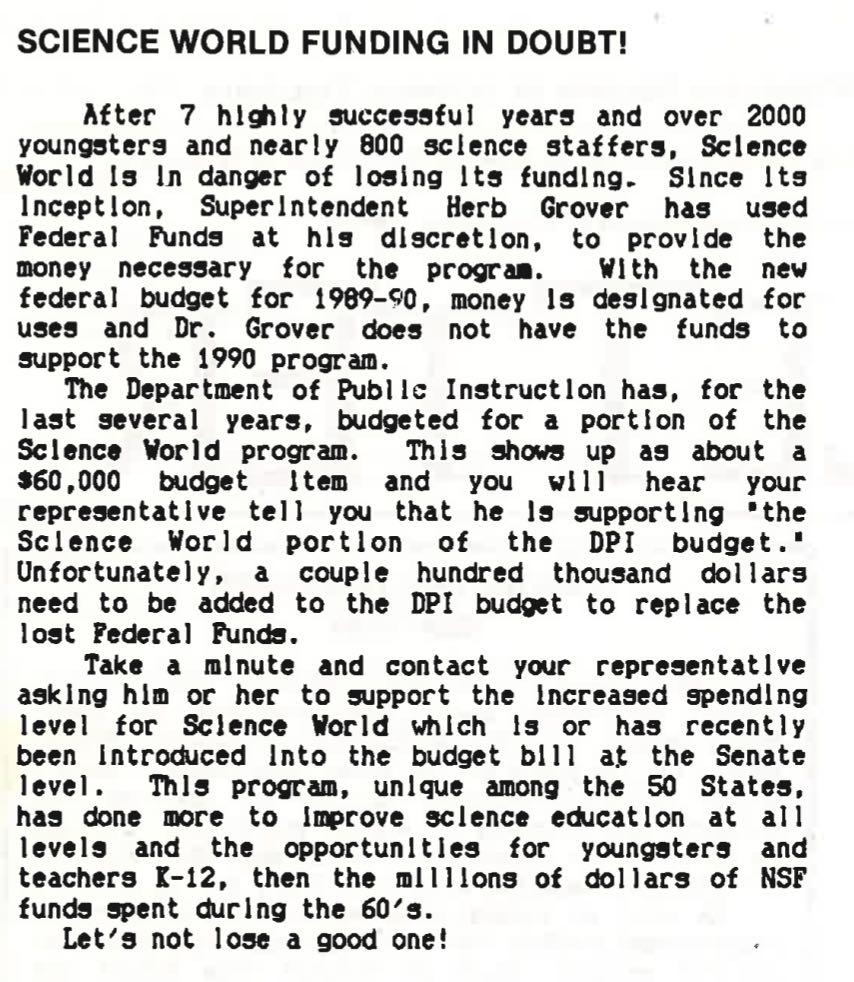
6 minute read
WSST and Professional Development in Wisconsin: a Story of Changing Relationships
WSST and Professional Development in Wisconsin: a Story of Changing Relationships
By Karyl Rosenberg, WSST Historian
In July 2023, I had the pleasure of visiting the WINGS program at Lowenwood in Land ‘o Lakes. Even being there for just a few hours reminded me of the wonderful WSST professional development connections I have made over my career. The enthusiasm shown by the presenters and participants was the same as I had experienced in programs like Science World, ESRA and WASDI. It got me to thinking: what is the story of such programs supporting Wisconsin science educators over our history? This is the theme I plan to follow during the next few newsletter issues. I decided to start with the original story of Science World. In addition to summarizing the information from past newsletters, I’ve also included a few clippings.
Switch your mind back to 1983 if you are old enough! An infamous report had just been released. Called “A Nation at Risk,” it detailed how the United States is falling behind other countries in educating our youth. The fall issue of the 19821983 WSST Newsletter showed a graphic that showcased a shortage of science teachers (especially physics teachers) as the average age of people in the profession had moved past the age of 40. In that
same issue, there is also discussion of the establishment of a program within the Wisconsin Academy of Sciences, Arts and Letters (hereafter WASAL) called CASE (the Center for Advancement of Science Education). This program was spearheaded by LeRoy Lee (a former WSST president who had become Executive Director of WASAL) and a number of other people from the UW system and DPI. Its goals were to provide opportunities for science educators to improve their knowledge of content and methods in a variety of areas. This turns out to be quite important.
Fast forward a few months to the Spring 1983 Newsletter, where we learn about an intensive program for 8th grade graduates called “Science World” that is being discussed by CASE in partnership with DPI and WSST leaders. “If funding is approved”, DPI Superintendent Herb Grover will announce it within “a few weeks”. Of course, funding is approved, and a pilot program starts with 40 students and a number of staff made up of outstanding junior high/middle school teachers at the Pigeon Lake Field Station. Generally, the pilot is a success, and the program is recommended for continuation.
By 1984, Steve Sandstrom, the program director is hired through DPI. Science World expands to include 360 students from around the state with a staff of 18 lead teachers in the student program. A staff development program for 120 junior high/middle school teachers is established with a variety of facilitators from higher ed and the science research and administration community. Considered unique and successful, this professional development experience is a one-of a kind statebased program. Sandstrom presents at 1985 WSST conference, and applications go out statewide for both student and teacher programs. On a personal note, I apply and am accepted. This turns out to be a career changing experience for me!
At the 1986 conference, those of us who were part of the teacher program presented activities we were inspired to produce because of our participation in Science World. For many of us, this is the first time we present at a WSST Conference (called conventions before 2007). Science World, with both student and teacher components, continues in the summer of 1986. However, Steve Sandstrom announces that he is resigning as director at the end of 1986.
In 1987, Science World has a DPI based program coordinator (Anne Conzemius). Don Byerly (as student program lead teacher) and Al Hovey (a former WSST president) share the on-site leadership role. As I had moved into a middle school position for 1987-1988, I participated again as I sought out help from Science World to navigate this new role. This time however, participants were required to share more than a presentation at the annual convention. We were asked to create a staff development program that would help local teachers as well as have the potential to help other schools. My “Environmental Infusion” program was shared with my fellow staff members, and I was invited to the Auburndale District to do the same thing!
Science World plans are in place for the summer of 1989, but the first sign of funding struggles raises its troublesome head. Federal science education funds are no longer considered discretionary for use by the Superintendent of Public Instruction; legislative approval is now needed. WSST members are encouraged to contact legislators, and a groundswell of support from Science World students and teachers follows. Through this advocacy, a group of legislators is able to see the value of Science World, and the program is once again saved for the budget 1990-1992 biennium.
In 1991, Don Byerly is named Science World director with rotating assistants from WSST leadership. However, Don would retire from the directorship. The program continues for five more years with state funding and rotating leadership from WSST and program coordination from DPI.
By 1999, it becomes clear that the legislature is losing interest in the Science World program and it is once again cut from the budget proposal. WSST leadership sets up a committee to save Science World, which sent a letter from the organ-
ization to all legislators. A lobbying effort was also started. However, this time, the program was not put back in the budget.
In 2000, the committee for Science World continues to work to revive the program for 2001. Questions arise about the longevity of CASE, and WASAL gets new leadership. An organized effort to let the legislature know the benefits of the program is coordinated by the WSST committee with many Science World alumni of both programs testifying before the Assembly Education Committee. The reception seemed positive, and WSST members were encouraged to contact their legislators.
Unfortunately, this was the last mention of Science World in the WSST newsletter archive. If anyone knows the specifics of the end of Science World, please let your Historian know. However, there is positive news to come as we investigate the other steps of WSST involvement in professional development across the later years of the last century and into the present one. Stay tuned!













